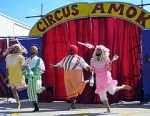|
Add to cart
Product added to the basket The stock is insufficient - units have been added to cart Total:
|
|
Out of stock
|
|
Minimum purchase quantity
The minimum purchase quantity is not reached
|
OUR OFFER
OUR INFORMATION
EXPRESS ORDERS
To learn more about clowns

To learn more about clowns
Clowns are comical performers, stereotypically characterized by their grotesque appearance: colored wigs, stylistic makeup, outlandish costumes, unusually large footwear, etc., who entertain spectators by acting in a hilarious fashion. The types of their acts varies greatly. Although many find clowns to be scary, their intended purpose is to entertain people, especially young kids.
Peter Berger writes that "It seems plausible that folly and fools, like religion and magic, meet some deeply rooted needs in human society." physical performance discipline, partly because tricky subject matter can be dealt with, but also because it requires a high level of risk and play in the performer. This has included the training offered by Jacques Lecoq. An example can be found in the Native American clown societies.
In slang, "being a clown", such as messing things up or blowing an opportunity is generally considered to be a negative thing.
Principal clown types
Whiteface
It is important to note that a whiteface character does not always wear the classic whiteface makeup. Additionally, a character can wear traditional whiteface makeup and be an auguste.
Classic appearance. Traditionally, the whiteface clown uses "clown white" makeup to cover his or her entire face and neck with none of the underlying flesh color showing. In the European whiteface makeup, the ears are painted red. Features, in red and black, are delicate. He or she is traditionally costumed far more extravagantly than the other two clown types, sometimes wearing the ruffled collar and pointed hat which typify the stereotypical "clown suit".
Character. The whiteface character-type is often serious, all-knowing (even if not particularly smart), bossy and cocky. He is the ultimate authority figure. He serves the role of "straight-man" and sets up situations that can be turned funny.
Some circus examples include Pipo Sossman, François Fratellini (the Fratellini family), Felix Adler, Paul Jung, Harry Dann, Chuck Burnes, Albert White, Ernie Burch, Bobby Kaye, Jack and Jackie LeClaire, Joe and Chester Sherman, Keith Crary, Charlie Bell, Tim Tegge, Kenny Dodd, Frankie Saluto, Tammy Parish, David Konyot (Circus Barum and The Toni Alexis trio), Jay Stewart and Prince Paul Albert.
Auguste
Appearance The auguste face base makeup color is a variation of pink, red, or tan rather than white. Features are exaggerated in size and are typically red and black in color. The mouth is thickly outlined with white (called the muzzle) as are the eyes. The auguste is dressed (appropriate to character) in either well-fitted garb or in a costume that does not fit - either oversize or too small is appropriate. Bold colors, large prints or patterns, and suspenders often characterize Auguste costumes.
Character The auguste character-type is often an anarchist, a joker, or a fool. He is clever and has much lower status than the whiteface. Classically the whiteface character instructs the auguste character to perform his bidding. The auguste has a hard time performing the task given which leads to funny situations. Sometimes the auguste plays the role of an anarchist and purposefully has trouble following the whiteface's directions. Sometimes the auguste is confused or is foolish and is screwing up less deliberately.
The contra-auguste The contra-auguste plays the role of the mediator between the whiteface character and the auguste character. He has a lower status than the whiteface but a higher status than the auguste. He aspires to be more like the whiteface and often mimics everything the whiteface does to try to gain approval. If there is a contra-auguste character, he often is instructed by the whiteface to correct the auguste when he is doing something wrong.
|
Alert
Please enter the required fields! |